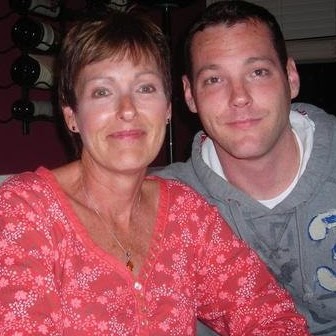Daniel E Peters
age ~63
from Thornton, CO
- Also known as:
-
- Daneil Peters
- Danielle Peters
- Daniele Peters
- Summer Peters
Daniel Peters Phones & Addresses
- Thornton, CO
- Arvada, CO
- Denver, CO
- Hanover Park, IL
- Redwood City, CA
- Sacramento, CA
- Carol Stream, IL
- Elmhurst, IL
- Chicago, IL
- New York, NY
- 380 Hacker Dr, Black Hawk, CO 80422
Work
-
Company:Tangent technology - Aurora, ILMay 2014
-
Position:Cnc machinist/setup
Education
-
School / High School:Illinois Manufacturing Foundation and Joliet Junior College- Joliet, IL2009
-
Specialities:Ex. in CNC Machinist
Languages
English
Specialities
Psychology
Lawyers & Attorneys

Daniel S. Peters - Lawyer
view sourceOffice:
Herzog Crebs LLP
Phone:
(314)2316700 (Phone)
Specialties:
Construction Law
Real Estate Law
Litigation & Appeals
Business & Commercial Law
Securities Law
Employment Law -- Employer
Real Estate Law
Litigation & Appeals
Business & Commercial Law
Securities Law
Employment Law -- Employer
ISLN:
909773562
Admitted:
1994, Missouri
University:
Southwest Missouri State University, Springfield, Missouri, B.S., Finance, 1987
Law School:
Saint Louis University School of Law, St Louis, Missouri, J.D., 1994
Links:
Site
Biography:
Daniel S. Peters, a partner in the firm, focuses primarily on commercial and business law matters. He is experienced in all levels of litigation and appeals and handles a wide variety of business rela...

Daniel Peters - Lawyer
view sourceOffice:
Herzog Crebs LLP
Specialties:
Litigation & Appeals
Construction Law
Real Estate Law
Environmental Law
Business & Commercial Law
Securities Law
Fiduciary Litigation
Employment Law
Maritime Law
Construction Law
Real Estate Law
Environmental Law
Business & Commercial Law
Securities Law
Fiduciary Litigation
Employment Law
Maritime Law
ISLN:
909773562
Admitted:
1994
University:
Southwest Missouri State University, Springfield, Missouri, B.S., 1987
Law School:
Saint Louis University School of Law, St Louis, Missouri, J.D., 1994

Daniel J. Peters, Lisle IL - Lawyer
view sourceOffice:
4200 Commerce Court, Suite 300, Lisle, IL
ISLN:
915437526
Admitted:
2000
University:
Michigan State University, B.S.
Law School:
Chicago-Kent College of Law, Illinois Institute of Technology, J.D.

Daniel Lawrence Peters, Palos Hills IL - Lawyer
view sourceOffice:
Daniel Lawrence Peters
9944 S. Roberts Rd., Ste. 201, Palos Hills, IL
9944 S. Roberts Rd., Ste. 201, Palos Hills, IL
ISLN:
920923625
Admitted:
1991

Daniel Scott Peters - Lawyer
view sourceISLN:
915372629
Admitted:
1991
University:
University of Hawaii, B.A.
Law School:
University of Hawaii, J.D.
Isbn (Books And Publications)






High Pressure Technology--2003: Shaping High Pressure Technology for the Future Presented at the 2003 ASME Pressure Vessels and Piping Conference, Cleveland, Ohio, July 20-24, 2003
view sourceAuthor
Daniel T. Peters
ISBN #
0791816966


Through Isaac's Eyes: Crossing of Cultures, Coming of Age, and the Bond Between Father and Son
view sourceAuthor
Daniel Barth Peters
ISBN #
0310203767
License Records
Daniel J Peters
License #:
17702 - Expired
Issued Date:
Sep 24, 1997
Renew Date:
May 31, 2002
Expiration Date:
May 31, 2002
Type:
Certified Public Accountant
Daniel Blatchford Peters
Address:
1801 California St STE 2900, Denver, CO 80202
License #:
28814 - Active
Issued Date:
Feb 5, 1993
Renew Date:
Nov 1, 2015
Expiration Date:
Oct 31, 2017
Type:
Professional Engineer
Name / Title
Company / Classification
Phones & Addresses
Owner
Gosewisch Kevin
Legal Services
Legal Services
9944 S Roberts Rd Ste 201, Palos Hills, IL 60465
Founder
Daniel Peters
Synthetic Rubber (Vulcanizable Elastomers)
Synthetic Rubber (Vulcanizable Elastomers)
175 E. 96Th Suite #15K, New York, NY 10126
Chief Technology Officer
Vaneck Global
Security Brokers, Dealers, and Flotation Comp...
Security Brokers, Dealers, and Flotation Comp...
99 Park Ave Fl 8, New York, NY 10016
Director Of Technology
G A Kraut Company Inc
Unit Investment Trusts, Face-Amount Certifica...
Unit Investment Trusts, Face-Amount Certifica...
485 Madison Ave Fl 4, New York, NY 10022
PRESIDENT
MEDI-PHYSICS, INC
2200 Cabot Dr STE 300, Lisle, IL 60532
101 Carnegie Ctr, Princeton, NJ 08540
101 Carnegie Ctr, Princeton, NJ 08540
President
Ge Healthcare Holdings Inc
Mfg and Whol Life Science and Nuclear Medicines · Whol Medical/Hospital Equipment · Druggists' Goods Merchant Whols
Mfg and Whol Life Science and Nuclear Medicines · Whol Medical/Hospital Equipment · Druggists' Goods Merchant Whols
3350 N Rdg Ave, Arlington Hts, IL 60004
(847)3988400, (847)2533704, (847)8186629, (800)6334123
(847)3988400, (847)2533704, (847)8186629, (800)6334123
Owner
Gosewisch, Kevin P., P.C.
Legal Services
Legal Services
9944 S Roberts Rd SUITE 201, Palos Hills, IL 60465
(708)4306973, (708)5990284
(708)4306973, (708)5990284
President
Summit Center: Helping Every Child Reach New Heights
Mental Health Care · Professional Organization
Mental Health Care · Professional Organization
700 Ygnacio Vly Rd SUITE 320, Walnut Creek, CA 94596
Us Patents
-
Interactive Phone System Utilizing Wireless Channels
view source -
US Patent:6990321, Jan 24, 2006
-
Filed:Apr 29, 1999
-
Appl. No.:09/303360
-
Inventors:Daniel V. Peters - Lisle IL, US
-
Assignee:NCR Corporation - Dayton OH
-
International Classification:H04B 1/40
-
US Classification:455 741, 455 661, 455557, 4555751, 455128, 455347, 37943301, 379434, 379447
-
Abstract:A telephone system for providing a telephony feature includes a phone system controller and a first telephone system interface. The first telephone system interface is coupled between a first telephone handset and a telephone line. Moreover, the first telephone system interface is operable to selectively couple the first telephone handset to the telephone line. The first telephone system interface is also operable to establish a first wireless control channel to the phone system controller. The wireless control channel is operable to carry control signals associated with the telephony feature between the first telephone system interface and the phone system controller. The phone system controller is operable to (i) receive the first control signals via the wireless control channel, and (ii) process the first control signals to provide the telephony feature to the telephone handset.
-
Encryption Key Distribution And Network Registration System, Apparatus And Method
view source -
US Patent:7310424, Dec 18, 2007
-
Filed:Dec 21, 2001
-
Appl. No.:10/032228
-
Inventors:Stephan Walter Gehring - Menlo Park CA, US
Daniel Paul Peters - Carlsbad CA, US
Jason Lee Ellis - San Diego CA, US
Satish Ananthakrishnan - San Diego CA, US -
Assignee:General Atomics - San Diego CA
-
International Classification:H04L 9/00
-
US Classification:380277, 380278
-
Abstract:A control method, apparatus, and system capable of securely distributing a shared secret network encryption key from a host to a wireless peripheral device. The sharing of the secret network encryption key is accomplished without the intervention of a man-machine interface at the peripheral. Embodiments enable a wireless device to receive and store multiple encryption keys, to select the appropriate encryption key depending on the network in range of the device, and thus to freely associate with multiple networks.
-
Optical Detector With An Overmolded Faraday Shield
view source -
US Patent:8071935, Dec 6, 2011
-
Filed:Jun 30, 2008
-
Appl. No.:12/165052
-
Inventors:David P. Besko - Thornton CO, US
Daniel J. Peters - Longmont CO, US -
Assignee:Nellcor Puritan Bennett LLC - Boulder CO
-
International Classification:H01J 27/14
H05K 9/00 -
US Classification:250239, 361818, 361820
-
Abstract:Embodiments described herein may include devices and methods of manufacturing devices for sensing and monitoring physiological parameters of a patient. Specifically, certain embodiments disclose the use of conductive and nonconductive overmold materials to protect the device, increase reliability, increase comfort, and increase accuracy of the parameters measured.
-
Tracheal Tube Locating System And Method
view source -
US Patent:8548564, Oct 1, 2013
-
Filed:Apr 3, 2009
-
Appl. No.:12/418454
-
Inventors:Daniel J. Peters - Longmont CO, US
Edward McKenna - Boulder CO, US -
Assignee:Covidien LP - Mansfield MA
-
International Classification:A61B 5/00
-
US Classification:600424, 12820026, 12820714
-
Abstract:According to various embodiments, a sensor may be placed on a patient chest adjacent to a desired position of a distal end of a tracheal tube. The sensor may be configured to emit an electromagnetic field into the patient and detect perturbations to that field caused by the presence of the tracheal tube. As the tube is inserted within the trachea, the sensor may detect the tube when the distal end passes within range of the sensor, indicating that a proper insertion depth has been reached. In certain embodiments, multiple sensors may be placed along the chest adjacent to the trachea to determine a distance between the tube and an anatomical structure. The distance information may provide an indication as to whether the tracheal tube is properly placed within the trachea.
-
Encryption Key Distribution And Network Registration System, Apparatus And Method
view source -
US Patent:20080069360, Mar 20, 2008
-
Filed:Nov 13, 2007
-
Appl. No.:11/939386
-
Inventors:Stephan Gehring - Menlo Park CA, US
Daniel Peters - Carlsbad CA, US
Jason Ellis - San Diego CA, US
Satish Ananthakrishnan - San Diego CA, US -
Assignee:GENERAL ATOMICS - San Diego CA
-
International Classification:H04L 9/08
H04L 9/16 -
US Classification:380259000, 380279000
-
Abstract:A control method, apparatus, and system capable of securely distributing a shared secret network encryption key from a host to a wireless peripheral device. The sharing of the secret network encryption key is accomplished without the intervention of a man-machine interface at the peripheral. Embodiments enable a wireless device to receive and store multiple encryption keys, to select the appropriate encryption key depending on the network in range of the device, and thus to freely associate with multiple networks.
-
Signal Processing Warping Technique
view source -
US Patent:20110071378, Mar 24, 2011
-
Filed:Sep 13, 2010
-
Appl. No.:12/880306
-
Inventors:Edward M. McKenna - Boulder CO, US
Daniel Jon Peters - Longmont CO, US -
Assignee:Nellcor Puritan Bennett LLC - Boulder CO
-
International Classification:A61B 5/145
-
US Classification:600364, 600300
-
Abstract:Methods and systems are provided for using time-frequency warping to analyze a physiological signal. One embodiment includes applying a warping operator to the physiological signal based on the energy density of the signal. The warped physiological signal may be analyzed to determine whether non-physiological signal components are present. Further, the same warping operator may be applied to signal quality indicators, and the warped physiological signal may be analyzed based on the warped signal quality indicators. Non-physiological signal components, or types of non-physiological noise sources, may be identified based on a comparison of the physiological signal with the signal quality indicators. Non-physiological signal components may also be identified based on a neural network of known noise functions. In some embodiments, the non-physiological signal components may be removed to increase accuracy in estimating physiological parameters.
-
Photoplethysmograph Filtering Using Empirical Mode Decomposition
view source -
US Patent:20110245628, Oct 6, 2011
-
Filed:Mar 31, 2010
-
Appl. No.:12/751274
-
Inventors:Edward M. McKenna - Boulder CO, US
Daniel Peters - Longmont CO, US
Youzhi Li - Longmont CO, US -
Assignee:Nellcor Puritan Bennett LLC - Boulder CO
-
International Classification:A61B 5/024
A61B 5/026
A61B 5/02
A61B 5/08
A61B 5/00 -
US Classification:600301, 600504, 600500, 600508, 600529, 600300
-
Abstract:Present embodiments relate to systems, methods, and devices for decomposing a physiological signal of a patient using empirical mode decomposition (EMD). In one embodiment, the EMD algorithm may involve identifying a frequency component, referred to as an intrinsic mode function, in the physiological signal. The physiological signal may be decomposed into one or more intrinsic mode functions through multiple iterations of the EMD algorithm. Each subsequent mode function may have a different frequency component of the original physiological signal input into the EMD algorithm. In some embodiments, each mode function may be further analyzed and/or processed to determine various physiological data corresponding to blood flow in the patient.
-
Systems And Methods For Determining Differential Pulse Transit Time From The Phase Difference Of Two Analog Plethysmographs
view source -
US Patent:20130137938, May 30, 2013
-
Filed:Nov 30, 2011
-
Appl. No.:13/307961
-
Inventors:Daniel J. Peters - Longmont CO, US
-
Assignee:Nellcor Puritan Bennett LLC - Boulder CO
-
International Classification:A61B 5/00
-
US Classification:600301
-
Abstract:Systems and methods are provided for patient monitors which apply phase detection operations to analog signals to identify differential pulse transit time (DPTT). Photoplethysmograph (PPG) signals measured at two sensor sites may be processed by a phase detection system to identify phase information that allows the calculation of a DPTT. The phase detection system may process analog PPG signals in the analog domain to determine phase information. In some embodiments, the phase detection system may process optical oximetry sensor signals to determine phase information using, for example, interferometric methods.
Medicine Doctors

Dr. Daniel B Peters, San Ramon CA - PHD
view sourceSpecialties:
Psychology
Address:
2333 San Ramon Valley Blvd Suite 125, San Ramon, CA 94583
(925)7431370 (Phone), (925)7431937 (Fax)
(925)7431370 (Phone), (925)7431937 (Fax)
Languages:
English

Daniel R. Peters
view sourceWork:
Nationwide Vision Laser Center
2222 E Camelback Rd STE 250, Phoenix, AZ 85016
(602)2652745 (phone), (602)9563300 (fax)
2222 E Camelback Rd STE 250, Phoenix, AZ 85016
(602)2652745 (phone), (602)9563300 (fax)
Education:
Medical School
Oral Roberts University School of Medicine at Tulsa
Graduated: 1985
Oral Roberts University School of Medicine at Tulsa
Graduated: 1985
Procedures:
Corneal Surgery
Lens and Cataract Procedures
Ophthalmological Exam
Lens and Cataract Procedures
Ophthalmological Exam
Conditions:
Cataract
Acute Conjunctivitis
Diabetic Retinopathy
Glaucoma
Keratitis
Acute Conjunctivitis
Diabetic Retinopathy
Glaucoma
Keratitis
Languages:
English
Spanish
Spanish
Description:
Dr. Peters graduated from the Oral Roberts University School of Medicine at Tulsa in 1985. He works in Phoenix, AZ and is affiliated with Banner University Medical Center Phoenix.

Daniel E. Peters
view sourceSpecialties:
Infectious Disease
Work:
Garden ID Group LLC
11211 Prosperity Farms Rd STE B105, Palm Beach Gardens, FL 33410
(561)6262914 (phone), (561)6262915 (fax)
11211 Prosperity Farms Rd STE B105, Palm Beach Gardens, FL 33410
(561)6262914 (phone), (561)6262915 (fax)
Education:
Medical School
Universidad Autu00F3noma de Guadalajara, Guadalajara, Jalisco, Mexico
Graduated: 2000
Universidad Autu00F3noma de Guadalajara, Guadalajara, Jalisco, Mexico
Graduated: 2000
Conditions:
Herpes Simplex
Herpes Zoster
Osteomyelitis
Septicemia
Acute Bronchitis
Herpes Zoster
Osteomyelitis
Septicemia
Acute Bronchitis
Languages:
English
Spanish
Spanish
Description:
Dr. Peters graduated from the Universidad Autu00F3noma de Guadalajara, Guadalajara, Jalisco, Mexico in 2000. He works in Palm Beach Gardens, FL and specializes in Infectious Disease. Dr. Peters is affiliated with Jupiter Medical Center and Palm Beach Gardens Medical Center.

Daniel F. Peters
view sourceSpecialties:
Gynecology
Work:
Fem Center
6221 Colleyville Blvd STE 150, Colleyville, TX 76034
(817)2516533 (phone), (817)2510340 (fax)
6221 Colleyville Blvd STE 150, Colleyville, TX 76034
(817)2516533 (phone), (817)2510340 (fax)
Languages:
English
Spanish
Spanish
Description:
Mr. Peters works in Colleyville, TX and specializes in Gynecology. Mr. Peters is affiliated with Texas Health Harris Methodist Hospital Southlake.

Daniel Frank Peters
view sourceSpecialties:
Surgery

Daniel B Peters, San Ramon CA
view sourceSpecialties:
Psychologist
Address:
2333 San Ramon Valley Blvd, San Ramon, CA 94583
Resumes

Daniel Peters Elgin, IL
view sourceWork:
Tangent Technology
Aurora, IL
May 2014 to Oct 2014
CNC Machinist/Setup
Aurora, IL
May 2014 to Oct 2014
CNC Machinist/Setup
Education:
Illinois Manufacturing Foundation and Joliet Junior College
Joliet, IL
2009 to 2013
Ex. in CNC Machinist
Joliet, IL
2009 to 2013
Ex. in CNC Machinist
Myspace
Googleplus

Daniel Peters
Lived:
San Francisco, CA
Lawrence, KS
Minneapolis, MN
Washington, DC
Maastricht, The Netherlands
Barcelona, Spain
Lawrence, KS
Minneapolis, MN
Washington, DC
Maastricht, The Netherlands
Barcelona, Spain
Work:
Google
OpenTable (2010-2011)
Vision Critical (2008-2010)
National Public Radio (2006-2008)
OpenTable (2010-2011)
Vision Critical (2008-2010)
National Public Radio (2006-2008)

Daniel Peters
Work:
Hobby Lobby - Stockman (2012-2013)
Education:
Homeschool
About:
My name is Daniel. That is all you need to know for now.
Tagline:
I am in love with Jesus Christ
Bragging Rights:
I have a cat named Pumpkin.

Daniel Peters
Work:
Vancouver Fashion Week - Backstage Coordinator (2010-2011)
Education:
Blanche Macdonald Centre - Fashion Merchandising, The Art Institute of Vancouver - Maketing and Managing in Fashion

Daniel Peters
Work:
Thomson-Reuters Corporation (2006)
Education:
Villanova University - Finance

Daniel Peters
Lived:
San francisco, ca
Work:
Beach chalet - Server
Education:
City College of San Francisco

Daniel Peters
Education:
University of British Columbia - Physics, Dalhousie University - Maths & physics
Tagline:
Raised in a blackberry patch

Daniel Peters
Work:
Self
Education:
UNI

Daniel Peters
Work:
Peters Family Racing
Education:
Mandan Junior High
Flickr
Classmates

Daniel Peters
view sourceSchools:
Capitol Christian Academy Upper Marlboro MD 1982-1986
Community:
Brenda Rezvan, Charlton Ho, Cathy Carbone, Dena Charvat

Daniel Peters
view sourceSchools:
Burt Elementary School Clarksville TN 1994-1998
Community:
Shannon Davis, Calvin Lawson, Candance Capotosti, Brittney Adkins, Tiffany Toner, Yvonne Griffin

Daniel Peters
view sourceSchools:
Burt Elementary School Clarksville TN 1994-1998
Community:
Shannon Davis, Calvin Lawson, Candance Capotosti, Brittney Adkins, Tiffany Toner, Yvonne Griffin

Daniel Peters
view sourceSchools:
Ponder High School Ponder TX 1996-2000
Community:
Christine Palmer, Edward Graham, Karen Schmitz, Edward Rogers, Sherie Buchanan

Daniel Peters
view sourceSchools:
Westchester Middle School Chesterton IN 2001-2005
Community:
Jordan Spaulding, Bill Adler, James Henkel, Bill Durkin, Amy Duemler

Daniel Peters (Boille)
view sourceSchools:
College Beliveau Winnipeg Palestinian Territory, Occupie 1993-1997
Community:
Tiana Bohemier

Daniel Peters
view sourceSchools:
Camden County High School Kingsland GA 1988-1992
Community:
Jennifer Sheppard

Daniel Peters
view sourceSchools:
Landstown Elementary School Virginia Beach VA 1992-1996
Community:
Jamie Martel
Youtube

Ryan Daniel Peters Jacks...
view sourceRyan Daniel Peters (Jacksonville, FL)

Daniel Peters Atlanta GA
view sourceDaniel Peters (Atlanta, GA)

Daniel Peters Australia
view sourceDaniel Peters (Australia)

Daniel Peters Lowell MA
view sourceDaniel Peters (Lowell, MA)

Daniel Peters Milwaukee WI
view sourceDaniel Peters (Milwaukee, WI)

Daniel Peters Chicago IL
view sourceDaniel Peters (Chicago, IL)

Daniel Peters San Franci...
view sourceDaniel Peters (San Francisco, CA)

Daniel Boniface Peters
view sourceGet Report for Daniel E Peters from Thornton, CO, age ~63



















